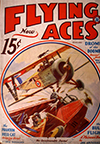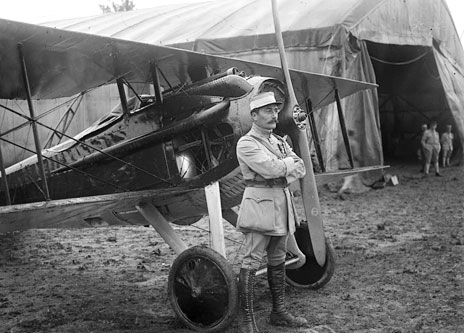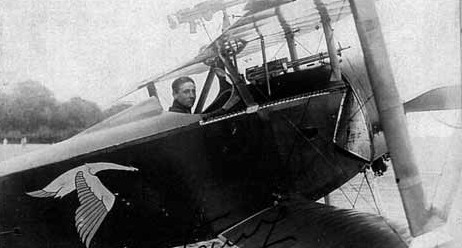“The Invulnerable Dormé” by Paul Bissell
THIS week we present another of Paul Bissell’s covers for Flying Aces! Bissell is mainly known for doing the covers of Flying Aces from 1931 through 1934 when C.B. Mayshark took over duties. For the January 1933 cover Bissell put us right in the action with
The Invulnerable Dormé
 “AND, Adjutant, get that request of transfer off to headquarters today, s’il vous plait?”
“AND, Adjutant, get that request of transfer off to headquarters today, s’il vous plait?”
“Certainement, mon Capitaine, but why so vite? There is not an aviator in all France who does not desire to be one of Les Cigognes. So with all the aviators to choose from, why do you ask for Dormé? He has had but little experience in le Chasse.â€
“Mon ami,†said the captain affectionately, “when a lad stationed at Paris flies an old Caudron up so close to the Front that he runs into a German squadron of six planes, he shows himself an ambitious and aggressive aviator. But when he then attacks them single-handed, brings one of them down and puts the rest to flight, he shows he has the stuff we want in Squadron 3. Don’t let’s lose him.†And the captain’s tone left no room for further argument.
So, early in July, 1916, René Dormé came to Squadron 3, better known as the Flying Storks, from the insignia painted on the side of their ships. This squadron had been formed by Captain Brocard and was already well known at the Front. It was destined later to enjoy a fame greater, perhaps, than that of any other French flying unit, and Dormé was to play no small part in helping to earn that fame.
In fact, he had been with the squadron but a few weeks when it was very evident that he was, as the French said, “un pilot extraordinaire.†He was quiet and gracious in manner, and was soon affectionately dubbed “Père†by his comrades, not because of his age—he was only 21—but because of the esteem and affection in which they held him.
Though he became one of the nation’s heroes, he remained always modest and unassuming. Twenty-three official victories were finally credited to him, but this was by no means his complete score. He often fought alone, far in the enemy’s territory, and his comrades knew that he had gained many a victory which went unrecorded. Once when a superior officer mentioned this fact in front of Dormé, Père quietly replied, “But the Germans know, mon Capitaine, and that is all that really matters.â€
Guynemer considered Dormé the greatest flyer of the war. The ability with which he maneuvered his little Nieuport was nothing short of miraculous. He helped develop air fighting tactics and is credited with being the first to make use of the great defensive stunt, the wing slip.
Battle after battle he would carry through to victory and emerge untouched. To the poilus he was known as “Dormé the Unpuncturable.†They said he could see the bullets and dodge between them. Certain it is that after his tenth victory his mechanics, going carefully over his plane, could not find one single bullet hole. Yet it was this ability to quickly maneuver which almost cost him his life, one morning in the summer of ’16.
JULY was almost over and Dormé was up early to bag himself a Boche to add to his record before the month’s end. He soon spotted a Fokker and swung around in a circle to prevent the black-crossed plane from turning back toward the German lines, at the same time tipping the nose of his little Nieuport up to gain altitude for the attack.
He reached his desired position, and with that quickness which marked all of his maneuvers in the air, swooped down in a power dive, his guns blazing. But here Fate took a hand to save the hapless German from Dormé’s deadly fire.
Completely absorbed in his maneuvers on the tail of the Fokker, Père had not noticed an Aviatic that had swung in from the left and been steadily creeping up under his tail. Evidently the pilot of this ship had just gotten himself in a position to fire on the unsuspecting Dormé when the Frenchman’s quick dive caught him so completely unawares that he was unable to twist his own ship out of the way and avoid a crash. The wheels of the little Nieuport struck the leading edge of the upper wing of the big Aviatic just where it joined the center section.
Luckily for Dormé, the Nieuport, ordinarily considered rather frail in its construction, this time proved the sturdier of the two planes. Though one wheel and part of the landing gear were crushed, a quick jerk of the stick on Dormé’s part yanked the little Nieuport out of danger while the Aviatic’s upper wing, broken at the midsection, swung away, carrying the lower wing with it, and the plane started in its mad dive earthward, the pilot finally jumping to avoid death by flames, the dread of all aviators.
Through the many months that followed, Dormé kept steadily gaining victories over the enemy. He ran neck and neck for many weeks in friendly rivalry with his fellow Cigogne, Captain Heurteaux, for the distinction of the premiere place of the squadron, until at last, when Heurteaux had gained a lead of a few victories, Dormé in a tremendous spurt shot down eight of the enemy in one short week and took a lead that he maintained until that day in May which was ever remembered as a black day for the Storks—the day when Dormé took off in the early morning light, never to be seen or heard from again.
For days the Cigognes kept secret the fact that he had failed to return, hoping against hope that Dormé would yet come back safely. It was more than a fortnight later when the Germans dropped a message on his field saying that Pilot Dormé had been killed in combat.
No data or particulars were given, and to this day there are thousands who refuse to believe that Dormé was brought down by the enemy. Père Dormé, the Beloved, the Unpuncturable, brought down by a German bullet? No! To the French this is unthinkable. But the fact remains that Dormé never came back.

“The Invulnerable Dorméâ€
Flying Aces, January 1933 by Paul J. Bissell






